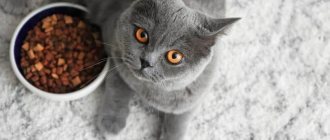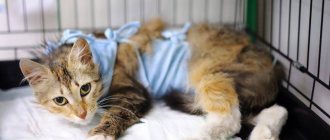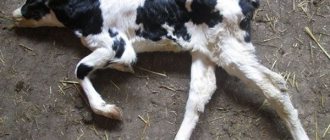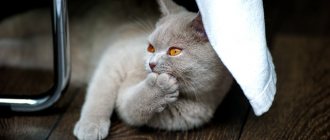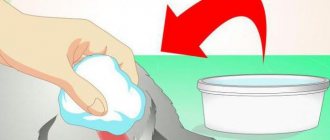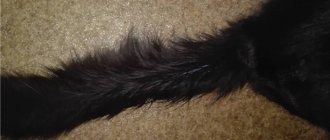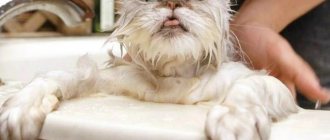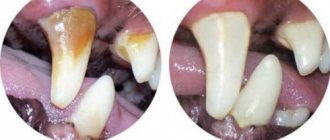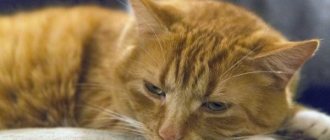Doctors are increasingly faced with the phenomenon of dehydration in cats. Since two-thirds of a cat’s body consists of water, its lack leads to irreversible consequences for the body. If the amount of fluid entering the body is 10% less than the required amount, it is possible to save the animal, but when this amount reaches 20%, dehydration leads to death. Why dehydration occurs and how to treat it is described in this article.
Causes
The cause of a lack of water can be pathologies occurring simultaneously in the body. Coping with the disease is possible only after successful procedures to restore water balance. Dehydration is usually caused by situations that accompany various diseases:
- change in temperature (during the occurrence of concomitant pathologies);
- vomiting, diarrhea (with gastrointestinal upset);
- excessive loss of fluid during urination and bowel movements (with kidney disease or diabetes);
- The lack of a container of water in a cat’s home becomes one of the main causes of dehydration in cats;
- staying outside for a long time in hot weather and getting heatstroke;
- inability to leave a closed, stuffy room for a long time;
- a situation in which the animal was severely injured and profuse hemorrhage occurred;
- feverish condition;
- being in a state of shock or stress during a long move, or acute pain during recent surgery.
Preventing dehydration
To prevent dehydration from developing, your cat should always have access to drinking water. The bowl of water must be changed every day. Do not leave animals for a long time in closed cars during the hot season or in closed, stuffy rooms.
It is also worth noting that if a cat is kept on ready-made industrial dry food, the body requires more fluid. Therefore, make sure that your pet has access to a drinking bowl.
If you experience frequent attacks of nausea, debilitating vomiting, or diarrhea, immediately contact a veterinarian. If your cat often drinks water or is constantly very thirsty, if there is frequent urination, do not delay your visit to the veterinary clinic.
How is the disease diagnosed?
If the epithelium is excessively dry, a cat is often diagnosed with dehydration. This can be detected by pulling the animal by the withers. In a healthy individual, it should immediately return to its place. If disease is present, the tubercle remains motionless for some time.
At home, you can perform the following test: open the animal’s mouth slightly and lightly press on the gums behind the upper teeth. If they have acquired a light shade, it persists for more than three seconds without immediately returning to its original state - this indicates illness. Probably, the capillaries fill very slowly because the cat is suffering from exicosis.
In a clinical setting, blood is taken for general and biochemical analysis. Additionally, the animal is examined for the presence of diabetes mellitus and kidney and liver pathologies.
Symptoms
The disease in an animal occurs with symptoms that can accompany various diseases, so it is necessary to show the pet to a doctor.
If an animal suffers from vomiting and diarrhea and does not drink water at all, this is an alarming sign.
The inability to defecate indicates insufficient fluid levels in the body.
If the oral mucosa is light in color, the saliva is viscous and does not excrete well, this indicates the presence of pathologies.
With existing infectious diseases and inflammation, the temperature can not only rise, but also fall. A sharp change in body temperature leads to profuse sweating and, accordingly, loss of large amounts of fluid.
So, let's name the main symptoms of the disease:
- dry skin;
- lethargy of the animal;
- sunken eyes;
- lack of normal appetite;
- constipation or diarrhea;
- arrhythmia;
- body temperature atypical for an individual;
- saliva viscosity;
- light shade of gums.
Causes and consequences of dehydration in cats
About two-thirds of a cat's body consists of water. If the body is dehydrated by more than 20%, it leads to death within a few hours. Kittens are especially sensitive to water imbalance. For them, 10% dehydration is enough to pose a serious threat to life.
An imbalance in the water balance in a pet’s body develops as a result of various factors:
- viral infections - panleukopenia ("feline distemper"), calcivirus infection, herpes and many other diseases occur against the background of severe dehydration;
- In case of poisoning and diseases of the gastrointestinal tract, vomiting and diarrhea are often observed. These symptoms also lead to dehydration, loss of important minerals from the body, and weight loss;
- chronic diseases. Excessive urination if you have diabetes or kidney failure may well lead to the development of a serious metabolic disorder;
- overheating in hot weather under the influence of direct sunlight leads to a lethargic state in the animal. If your cat is so overheated in the heat that it is unable to drink on its own, immediately call a veterinarian;
- intoxication with signs of poisoning. The reasons may be different: the cat inhaled toxins, was poisoned by household chemicals, or ate expired food;
- a stressful state as a result of nervous shock. Cats, like people, can become depressed. Moving or bringing a new pet into the home can lead to the development of pathology;
- consequences of surgery. The postoperative period is characterized by weakened immunity and the likelihood of side effects, one of which may be dehydration;
- blood loss. If the cat has been in a fight or is suffering from blood loss for another reason, it requires urgent hospitalization.
Treatment
If signs of dehydration are noticed, you should immediately begin procedures to restore water balance.
When the above symptoms (not vomiting) are detected, you can try to forcefully inject the cat with water or an aqueous solution with salt and granulated sugar into the oral cavity.
If vomiting, you can inject a solution of sodium chloride or glucose (10 ml) into the cat’s withers. Additionally, you can administer 1 ml of Gamavit. When purchasing livestock, it is better to learn how to give injections from a veterinarian in advance.
Such manipulations will save the cat from loss of moisture and minerals, and help his body before contacting a doctor. Loss of beneficial components can lead to death, while treatment of the concomitant disease can be done later.
At the clinic, cats are treated through intravenous infusions. The cat is brought into the treatment room and fluid is replenished through droppers with a solution that ensures normal vital functions. If it is not possible to regularly attend procedures with a cat, it is left under the supervision of a specialist in a hospital, where treatment procedures are performed.
Emergency care and follow-up treatment
Of course, the best thing is to urgently take the animal to the doctor, carry out the necessary tests and find out the root cause of dehydration, but what to do if the pet’s condition is urgent, how to properly provide assistance?
We move the animal to a cool, dark place and offer a drink. If the animal drinks on its own, we observe, it is quite possible that the absorbed water will not be enough to compensate for the losses and dehydration will progress. Even if the animal does not want to drink, try to stimulate the cat to act, moisten it, let him lick the water off his fingers, pour a little liquid into the mouth from a syringe without a needle, add special flavors to the drinking bowl.
Treatment of the disease involves the introduction of fluid from the outside. Pull back the skin on the animal's withers and inject a saline solution with glucose. Inject the solution slowly so that it has time to dissolve, thoroughly rub the injection site after removing the needle. Even if the animal feels better, it is recommended to visit a veterinarian for diagnosis; the doctor will tell you how to treat the animal and restore the full value of the water balance. In case of severe dehydration, fluid infusion is performed intravenously - droppers are placed.
Preventive measures
To prevent exicosis, you need to follow simple rules:
- keep a bowl of your favorite liquid within walking distance of the animal;
- if there is more than one cat living in the house, it is better to provide each of them with individual dishes;
- when treating any disease, monitor the cat, monitor its appetite and thirst;
- Along with dry food, give your cat wet food;
- monitor the time the animal spends in direct sunlight;
- If you are urinating frequently, have your pet examined by a doctor.
Some individuals prefer to drink running water. You can install a special drinking fountain for them.
To prevent a sensitive cat from touching the bowl with its whiskers, it should be low and spacious.
Recommendations
It is necessary that the domestic cat always has access to drink. If your cat doesn't drink enough water, you can replace dry food with wet food, which contains about 70% moisture, or add water to the food.
In case of some problems, for example, chronic renal failure, regular fluid administration is recommended for cats due to poor kidney function. In this case, the veterinarian may prescribe subcutaneous injections of solutions to the cat in a certain amount at a certain interval.
Some animals drink quite a bit and this will not be a pathology if the pet has regular bowel movements, normal turgor, good general health and moist mucous membranes.
Forecast
If you become dehydrated, it is important to take action quickly. When all fluid restoration procedures have been completed, the cat's chances of quickly curing the disease that led to dehydration increase.
If the cause of dehydration is a simple lack of fluid intake, the animal quickly recovers after receiving injections and replenishing moisture in the cells and connective tissues. The speed of recovery depends on the age of the cat, the presence of chronic diseases and the state of immunity.
Every owner needs to know how to treat dehydration in a cat, including at home. This will allow her to live without worries and please others for a long time.
Symptoms
Visual signs of dehydration include sunken eyes, ruffled fur, dry gums, and sticky saliva. The following degrees of dehydration are distinguished:
- Low.
- Moderate.
- High.
A low degree of dehydration occurs with a loss of 5% of the initial moisture, is a consequence of physical overload and does not cause clinical symptoms. With moderate dehydration, moisture loss is 5–10%. A felinologist can independently identify this phase of the disease by detecting the following clinical symptoms:
- saliva viscosity increased;
- the elasticity test shows that when the skin is pulled back at the scruff of the neck, it does not return to its original state immediately;
- determination of the rate of capillary filling - a whitish mark on the gum after pressure normally disappears in 2 seconds.
In obese animals, the skin remains elastic even when dehydrated. In kittens and immature adolescents, the return of the retracted skin to its original position occurs more slowly than in adults.
With a high degree of dehydration, the cat does not drink, does not eat, lies down, and there is no reaction to what is happening. In this condition, the animal needs immediate veterinary care.
With panleukopenia, dehydration develops. The cat doesn't react to anything
